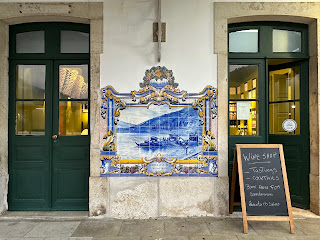Tuesday 30 January 2024
A few days ago we were sat on the cliffs at Nazaré, along with about a thousand other people, gazing out to sea from the headland above Praia do Norte (North Beach). From our viewpoint the waves seemed moderate in height - in reality they were probably about 6 meters high.
The reason Nazaré is a mecca for surfers is the big waves generated by a huge underwater canyon just offshore. The effect this canyon creates in conjunction with Atlantic swells, wind, tides, currents and two waves patterns colliding at this point on the coast results in this being one of the best places in the world for surfing. For a more detailed explanation follow this link: Nazaré Canyon
There’s a small Surf Museum in the Lighthouse on the headland with lots of information about the science behind the huge waves here. On display are also many surfboards including those of the current Guinness World Record holders. The records are held by a German man (wave height 26m/86ft) and a Brazilian woman (wave height 22m/73ft) both of which were recorded at Nazaré.
A slightly different waiting game is that of cork production in Portugal. Crossing the country, from Nazaré on the west coast to Elvas on the eastern border with Spain, we drove through miles of cork oak tree forests. Portugal, in particular this region called Alentejo, is by far the world's leading producer of natural cork suppling about 60% to the industry and this mainly comes from the 1.8 million acres of managed land called ‘montado’.
Driving along the forests the stark bare trunks of the trees look like they’ve been vandalised but it’s a highly regulated and carefully managed industry. As the bark is only stripped every 9 years and the lifetime of a cork oak tree is about 270 years it’s definitely a sustainable industry. It requires skill and a lot of experience to avoid damaging the tree. Finding the deepest crack on the cork bark a vertical cut is made with an axe which is then twisted to separate the outer from the inner bark.
As Maya Angelou said … ”All great achievements require time”.




























































